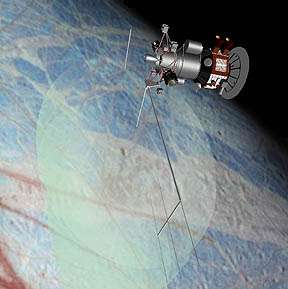Europa Orbiter
The Europa Orbiter[1] was a planned NASA mission to Jupiter's Moon Europa, that was cancelled in 2002.[2] Its main objectives included determining the presence or absence of a subsurface ocean and identifying candidate sites for future lander missions.[3] Europa Orbiter received pre-project funding in 1998, and resulted from NASA's Fire and Ice project.[3]

History
Europa Orbiter was a design for a mission to the Jovian moon Europa, based on a 900 kg (1984 lb) orbiter, of which 500 kg (1102 lb) was fuel for maneuvers.[4] It would have been powered by RTG power and 2003 launch from the Space Shuttle.[4] This would have meant an arrival at Jupiter in 2007, at which time it would commence in three-part science tour focused on Europa.[4] The spacecraft would be radiation hardened to survive a predicted 4 megarads of radiation.[4]
The science payload would include a radar to determine the thickness of ice at Europa, and determine what was below it.[5] Other instruments would be an altimeter and imaging systems, among other devices.[6]
In 1999, NASA issued an announcement of opportunity that solicited experiments for Europa Orbiter, Pluto/Kuiper Express, and Solar Probe.[4]
The results of the studies on the Europa Orbiter have been conducive to the Jupiter Europa Orbiter (JEO), NASA's contribution to the planned international Europa Jupiter System Mission (EJSM) that was slated for launch in 2020. EJSM was cancelled in 2011.
The Europa Orbiter-concept should not be confused with the Jovian Europa Orbiter, a feasibility study conducted by the European Space Agency which was finally superseded by the EJSM, too.
Another Europa mission in this era was the Europa Ice Clipper, a Stardust mission-like sample return mission.[5]
The next NASA mission to Jupiter was Juno, which was selected in 2005 as the next New Frontiers mission after New Horizons.[7] It was launched in 2011 and arrived at Jupiter in the summer of 2016.
A 2002 paper noted the following challenges for this mission "substantial energy required for a direct trajectory, the long duration of the mission, the high total-radiation dose, and the need for radioisotope thermoelectric generators"[8] One mission plan involved first entering Jovian orbit, then use multiple gravity assists from the Moons of Jupiter to help it to enter the orbit of Europa with less rocket fuel.[9]
.jpg)
Legacy
Later in the 21st century, it was suggested the goal of the Europa Orbiter should have been to find places where the freshest sub-surface material had been brought the surface.[10] This location would then be the target of a lander which could study what would hopefully be subsurface material, without having to drill down through the ice layer.[11]
Another aspect that has been noted was that this concept was studied about three years leading up to its cancellation in 2002.[11] After Europa Orbiter NASA turned its attention to a nuclear fission powered orbiter for Europa for Project Prometheus.[11]
Comparison
Comparison of notional NASA missions targeting Jupiter's moon Europa.
| Name | Time Period | Power | Launcher |
|---|---|---|---|
| Europa Orbiter | 1999–2002 | RTG | Space Shuttle |
| Jupiter Icy Moons Orbiter | 2004–2005 | Fission | Delta IV Heavy |
| Jupiter Europa Orbiter (EJSM ) | 2008–2011 | RTG | Delta IV Heavy, Atlas V, etc. |
| Europa Clipper | 2015– | Solar | Misc. Options |
See also
- List of NASA cancellations – Wikipedia list article
- Europa Clipper – Planned multiple-flyby study of Europa
- Jupiter Europa Orbiter
- Europa Lander (NASA) – A proposed NASA lander for Europa
References
- The Europa Orbiter Mission Design
- NASA Kills Europa Orbiter
- "Europa Orbiter".
- Committee on Planetary and Lunar Exploration; Commission on Physical Sciences, Mathematics, and Applications; Space Studies Board; Division on Engineering and Physical Sciences; National Research Council (2000). A Science Strategy for the Exploration of Europa. National Academies Press. p. 24. ISBN 978-0-309-51657-0.CS1 maint: multiple names: authors list (link)
- "Galileo buzzes Europa | Science Mission Directorate". science.nasa.gov. Retrieved 2017-02-15.
- "Galileo buzzes Europa | Science Mission Directorate".
- "Juno Mission to Jupiter". Astrobiology Magazine. June 9, 2005. Retrieved December 7, 2016.
- "Europa orbiter mission concept". 2002-07-08.
- Heaton, Andrew F.; Strange, Nathan J.; Longuski, James M.; Bonfiglio, Eugene P. (2002). "Automated Design of the Europa Orbiter Tour". Journal of Spacecraft and Rockets. 39 (1): 17–22. doi:10.2514/2.3801. hdl:2060/20000055760. ISSN 0022-4650.
- Richard Greenberg (2004). Europa – The Ocean Moon: Search For An Alien Biosphere. Springer Science & Business Media. p. 339. ISBN 978-3-540-22450-1.
- Greenberg, Richard (2004). Europa – The Ocean Moon: Search For An Alien Biosphere. Springer Science & Business Media. p. 339. ISBN 978-3-540-22450-1.

